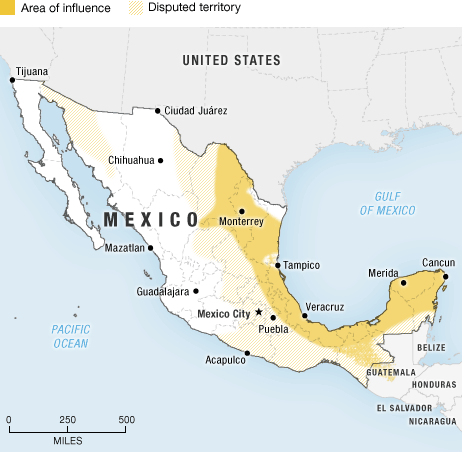Drug Coverage
If you work for a large enough organization, especially in certain roles, there’s a good chance that your employer will pay for your mobile phone contract. The idea, of course, is that you’re expected to be nearly always available and, if your employer wishes that sort of access, the least it can do is handle the burden of the monthly phone bill.
But what if you work for a murderous, pull-no-punches drug cartel?
In one case, the drug lords did a lot more than pay for their workers’ phones.

The Zetas are a well-known drug cartel in Mexico, operating in the area above (map via NPR). What makes the Zetas particularly dangerous is their origins and training. In 1999, a group of elite commandos in the Mexican Army deserted and, instead, joined a syndicate known as the Gulf Cartel. Those soldiers, in 2010, broke off from the Gulf Cartel and began their own, creating what has since been known as the Zetas. The Zetas are, to say the least, not a group to be trifled with. According to the group’s Wikipedia entry, “their brutal tactics, which include beheadings, torture, and indiscriminate slaughter, show that they often prefer brutality over bribery.”
Communication throughout their huge geographic territory requires some ingenuity, especially because Mexican law enforcement would love to listen in on the Zetas’ conversations. The syndicate’s members and leadership have the resources to stunt such eavesdropping attempts, and one such result came to light in late 2011. That year, the Mexican military announced a raid netting “167 antennas, more than 150 repeaters and thousands of cell phones and radios,” according to NPR. The Zetas hadn’t just bought a collection of pay-as-you-go phones. They had surreptitiously built their own cartel-only cellular and radio networks, stretching from the U.S border to the north all the way south to Guatemala.
The networks were not as secure as the cartel would have liked — that above-linked NPR article suggests that Mexican (and U.S.) officials could tap into it to some degree. Nevertheless, the authorities raided the system and shut it down, likely in order to disrupt on the ground communications within the syndicate. According to the New York Daily News, the Zetas used the system at a very granular level, allowing gang members to warn one another about roadblocks or oncoming law enforcement agents, and this use was probably stifling on-the-ground legal enforcement from performing its duties.
But perhaps more shocking is how the Zetas built the system in the first place. While the equipment used was expensive — in the realm of millions of dollars — it was comprised of items which could be legally acquired, and let’s face it, the price tag isn’t a problem for organized crime of this scale. On the other hand, a collection of paramilitary operatives don’t know a lot about building or maintaining large-scale wireless networks — you’d need people with years of experience managing such systems. Most likely, the Zetas kidnapped and enslaved the required talent. Three dozen or so Mexican engineers have disappeared over the last few years, and most authorities agree that they’re being employed, against their will, by the Zetas.
Bonus Fact: Another way drug cartels avoid the authorities? Submarines. Colombian cartels often use them to smuggle product into Mexico and other points in Latin America. In one notable bust, American officials stopped a “narco-sub” (as they are often called) carrying seven tons of cocaine worth well over $8 million.
From the Archives: Driving Data: How your cell phone tracks your location, in a good way. (Probably.)
Related: “El Narco: Inside Mexico’s Criminal Insurgency” by Ioan Grillo. 4.4 stars on 153 reviews.
